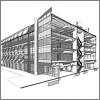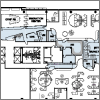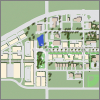
Architecture

Interior Design

Urban Design
Our work, upon reflection, always leads us to the consideration of with whom we work and their needs. Our deep engagement with the architecture of commerce sharpens our tuning to what we work with, how we work with it, and how it invades and invents processes. We obtain to projects that reflect what we deeply believe- architecture is that little something beyond mere construction.
So we accept a kind of ethical binding matrix as a result of accepting every client rather than looking for the right ones, approaching each project on its own terms and inventing with what we find when doing so. No” live, work, play “gimmicks for us. We live with a kind of split personality disorder- the “projects” and the “work” as it sometimes comes down. The things that seem open to potential and those that seem closed define the spirit of Powers Brown Architecture, our ability to cross-pollinate and leverage the opportunities within each project and between them.
While Architecture and Interior Design are unarguably intertwined, for us there is no doubt that conceiving, shaping, and materializing interior environments requires a dedicated aspect of our practice and research. The Interior Design group focuses on projects ranging from tenant fit-out and lobby design to nightclubs and restaurants. The practice group and our clients form a team and together develop a strategy for the planning, design, and delivery of the client’s space on time and within budget. Powers Brown Architecture believes in integrated solutions with services that include programming, planning/restack, landlord services, design, FF&E, inventory, and documentation. Our “difference” in our interior approach relies upon the ability to synthesize the Fundamentals and the Trends. Fat Free Design, Millenialization and Mobile Work Place Solutions have to be mediated by Space Inventory / Management, Programming and FF&E Inventory.
Urban design results in a meaningful interface between people buildings and space. It relies upon the integration of composition and demographics. It is not planning, nor can it be easily reduced to the tropes of Town Centers, Lifestyle Centers, Horizontally integrated and nonintegrated Mixed Use and so on. It is the essential element in each of these strategies, not an end in and of itself. Our fundamental definition of Planning versus Urban Design (we distinguish between the two disciplines but also see them as inherently interdependent) comes down to what we deem Site Making and Place Making. Planning, in very general terms, deals more with Site Making. That is to say, planning emphasizes in our opinion the creation of community structure and coherence through regulation and policy more than with building form. This is an important skill in interacting with the complex amalgamation of entities that make a community and have a stake in its propagation. Many with whom we will interface are not as familiar with the types of drawings and complicated interaction between land and buildings as they are with regulatory instruments, economic formulations, and abstractions such as wealth in the community as determined by education, income, and so on. In some ways we view it as the essential first step two dimensional cousin to urban design.